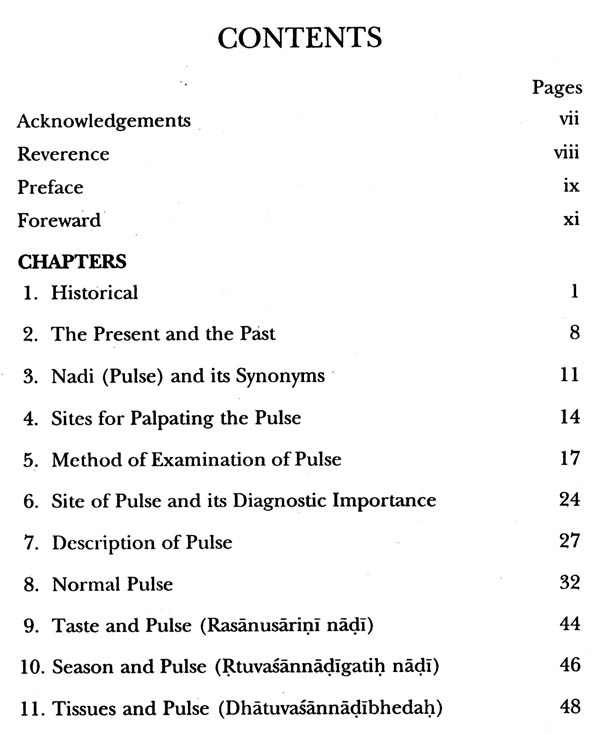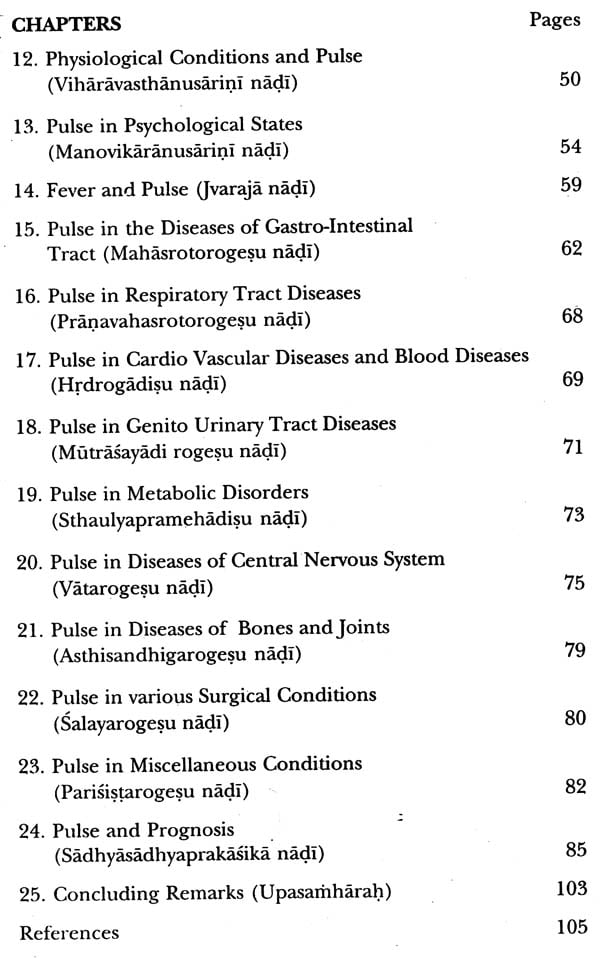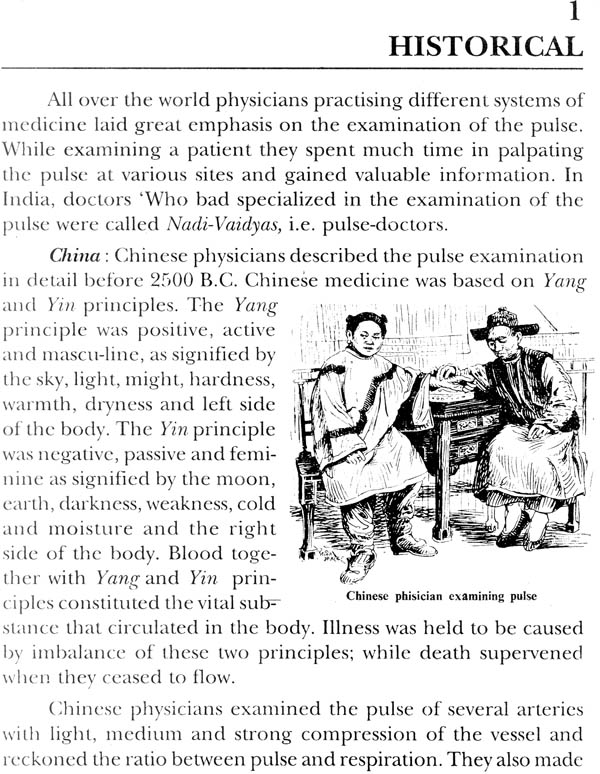
Pulse
Book Specification
| Item Code: | NAV397 |
| Author: | V. B. Athavale |
| Publisher: | Chaukhamba Sanskrit Pratishthan |
| Language: | Sanskrit and English |
| Edition: | 2017 |
| ISBN: | 9788170841453 |
| Pages: | 121 (7 B/W Illustrations) |
| Cover: | HARDCOVER |
| Other Details | 9.00 X 6.00 inch |
| Weight | 290 gm |
Book Description
From time immemorial, examination of pulse has been one of the most important diagnostic tools relieved on by all systems of medicine. The art and science of examination of pulse was well developed in ancient India.
Character of the pulse gives information about the constitution of a person. The variations in pulse in different seasons and eating diet with different taste are mentioned. How the psysiological conditions like sleep, exercise, obsesity and pregnancy affect the rate and character of pulse is described. Similarly various psychological conditions which modify the character of pulse are described.
The rate, quality and character of pulse in different fever & diseases of digestive tract, metabolic disorders, diseases of bones and joints and various surgical conditions are described in detail. As a corollary by examination of pulse, the physician could diagnose the various diseases.
Pulse also serves as an important tool for giving the prognosis. However one has to study pulse of thousand of person to be able to give the diagnosis and prognosis of various diseases.
Dr. V.B. Athavale M.B.B.S., D.C.H., M.D. (Paed.) M.A.M.S., F.A.M.S., and Vaidyacharya is a renowned Paediatrician, and an eminent author who has several noteworthy achievements to his credit. He did his M.B.B.S. from Grant Medical College and Sir J.J. Group of Hospitals, both in Mumbai, stood first in D.C.H. (C.P.S.) 1956, and completed M.D. (Paed.) in 1958.
Dr. Athavale was chairman of the workshop on ‘Herbal Medicines for Health for the Developing Countries, which was held at Bangkok in the year 1981. Dr. Athavale worked as a Honorary Professor and Head of Department of Paediatrician, L.T.M.G. Hospital, Sion, Mumbai during 1970 to 1990 and was recognised for his various accomplishment for which he has been bestowed with honours and awards, both Naional and international.
Dr. Athavale has also authored more than a dozen books on Ayurveda, for which he has been conferred upon the International Award for the best author of Ayurvedic books in 1997. V.B. Athavale Research Foundation has been founded as a mark of respect and gratitude to Dr. Athavale when he retired after 30 years of selfless service as Hon. Professor and Head of Department of Paediatrics, L.T.M. Medical College and L.T.M.G. Hospital, Mumbai.
(Ravana)
From time immemorial, examination of the pulse has been one of the most important diagnostic tools, relied on by all systems of medicine. We have all heard anecdotes of an accurate diagnosis made by eminent Ayurvedic physicians by examination of pulse alone. Are these statements exaggerated? What is the scope and what are the limitations of knowledge gained by the examination of pulse?The art and science of examination of pulse was well developed in ancient India. Fortunately some of the ancient Ayurvedic literature is still available to us. A humble attempt is made here to compile most of the literature on pulse in a systematic manner. The literal meaning of the texts as far as possible has been adhered to and the basic concepts are presented in the original form. The relevant Sanskrit stanzas together with references are also given. Ayurvedic literature on pulse includes the description of the condition of the vessel wall, flow of blood and the impulse which depend on the characteristics of the blood and other factors. For example when the pulse is described as hard, tremulous, fast, and hot, it implies that the vessel wall is hard, the impulse is tremulous, the rate is fast and the blood flowing through it is warm.
This book gives us an idea about the magnitude of information which could be gained by an experienced physician trained for years by an experienced teacher. I am certain that this monograph will be useful to all physicians, cardiologists, as well as those interested in medical history.
Pulse is an important diagnostic tool for all physicians. It is vital to understand the normal pulse and its mechanism. While examining the pulse one should look for the rate of pulse, condition of the vessel wall and the character of the impulse. The pulse varies with age, sex, constitution, time of day, season, activity, meals, the state of mind of the individual, etc. Children of Kapha constitution for example will have the typical pulse of Kapha characteristic only when examined in the morning, in spring, after food and rest and when in a happy state of mind. When anyone of these factors vary; the character of the pulse will change according to the dominant dosha of that particular factor.
As Kapha molecules are heaviest and Vata molecules lightest, with every cardiac impulse, the heavy Kapha molecules will be best appreciated by the palpating proximal ring finger. Vata molecules will be moving faster and will be best felt by the palpating distal index finger. The pulse should be palpated at different sites for diagnosing diseases of various organs. At all these different sites the finger nearer the heart will give an idea about Kapha dosha, the middle finger Pitta dosha, and the finger away from the heart will throw light on Vata dosha in the body.
While palpating the pulse of the patient, it is important to remember that every disease has its own dominant dosha, e.g. in diabetes-kapha, in fever-pitta and in neurological disorders Vata is more dominan t. This should be kept in mind while interpreting the pulse. In disease states, examination of the pulse throws light on the gravity of the illness and gives a guide line for the prognosis.
The human body and its components including the cardio- vascular system the blood vessels as well as the blood flowing through them are composed of the same five basic elements (Panchamahabhuta) or the tissue biological elements, viz. Vata, Pitta, Kapha which constitute the entire universe. Hence, the state of any tissue or organ in the body will affect the balance of these biological elements which in turn will be reflected in the pulse.
Abnormal states of the body which predispose to disease will disturb the balance of Vata, Pitta, and Kapha and be reflected in the pulse.
There is no mystery or myth in the surprisingly accurate diagnosis of Nadi vaidya. An intelligent physician can acquire mastery over pulse examination by diligently palpating thousands of normal and abnormal pulses under the guidance of an experienced teacher.
The author Dr. V. B. Athavale, M. D., D.C.H., M.A.M.S. is a renowned pediatrician and is professor of pediatrics at the Municipal Medical College, Sion, Bombay. Even after attaining the highest degree in Ayurveda, i.e. "Vaidyacharya" he utilises every minute of his spare time in pursuing his studies in Ayurveda most diligently.
Calm and modest by nature he is a devoted student who respects his teachers. He has studied in depth allied sciences like shaddarshanas. He is a good teacher, an intelligent research worker and a successful practitioner. Much more important is the fact that he puts into practice what he has learnt from various sciences for the benefit of his patients.
In this book the author has dealt with the entire literature on pulse as given in Ayurveda in a masterly manner. This book is so comprehensive that there is. no need in future to refer to any other book on pulse. This book will be useful to students, physicians and teachers alike.
All the physicians of India whatever the system of medicine they are practising should be proud of our rich heritage of Ayurveda. It is upto us doctors and Vaidyas to explore these realms for the benefit of humanity.
**Contents and Sample Pages**











